Navigation
-
Badge History
- Eagle Scout Medals
- Eagle Scout Badges
- Eagle Scout Pins
- Eagle Scout Square Knots
- Boy Scout Cloth Rank Badges
- First Class Scoutmaster
- Scouting's First Ranger Award
- Did You Know?
- Square Knot Evolution
- Cub Scout Badges
- Cub Scout Uniform
- Den Mother History and Badges
- Silver Outranks Gold
- National and Private Issue Venturing Badges
- Scout Leader Pins
- Die Cut Rank Badges
- Commissioner Badges
-
Other Links
-
References
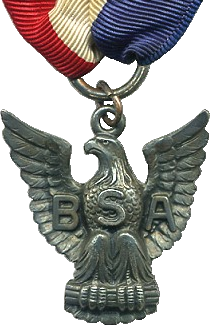 Eagle Scout Medals
Eagle Scout Medals
The Eagle Scout award medal has always been the same basic design. The first Boy Scout Handbooks illustrated other designs but they were never created. The first Eagle Scout medal was presented in August 1912.
T.H. Foley: 1912-1915
The T. H. Foley Company was the first to make the Eagle Scout medal. They produced the medals from 1912 until 1915 when they went out of business. During those years, 338 Eagle Scout medals were issued so Foley medals are the scarcest.
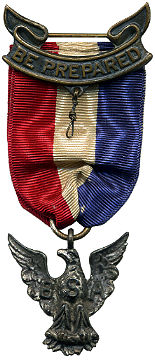

The composition of the pendant and scroll is bronze washed in silver. Often they have the appearance of being gold in color because the silver easily wore off. On the back of the scroll is the manufacturer's hallmark and the clasp on the scroll was a simple hook clasp. There is no hallmark on the pendant and the pendant ring can be either perpendicular or parallel to the plane of the wings. There are both single and double knots hanging from the scroll.
Dieges and Clust: 1916-1920
After the T. H. Foley Company went out of business, the National Office contracted with Dieges and Clust to make the Eagle Scout medals. Their first medal was issued in 1916 and they continued making them through 1920. According to records, 1,640 Eagle Scout medals were given out during those years.
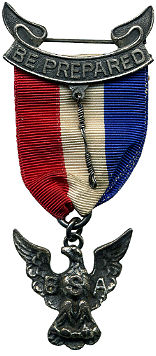
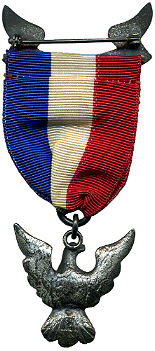
An interesting feature of the Dieges and Clust medal is the long double knot hanging from the scroll. This medal was made of sterling silver. Some pendants and scrolls have the word sterling stamped on them, others do not. The clasp on the scroll was a locking clasp.
Robbins: 1920-1978
In 1920, the National Office contracted with the Robbins Company to manufacture the Eagle Scout medal. They made the medals through 1978, all were sterling silver. During the course of that time, they made 6 distinct types with a number of variations.
Back of Pendant
Types 1A, 1B and 1C all have a notch (^) where the tail feathers meet the body. Type 1D has a straight line.

^ Notch
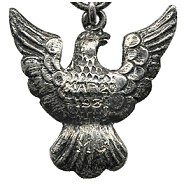
No Notch
Beak
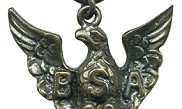
Beak Closed: Type 1A and 1B
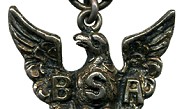
Beak Open: Type 1C and 1D
Type 0: 1920

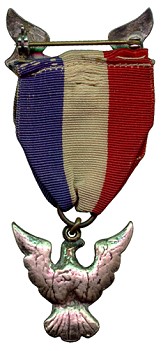
The first Robbins medal was basically the same design as the Dieges and Clust which includes an indistinct pattern of lines on the back. The difference is primarily in the scroll. The lettering in the Robbins Type 0 is smaller than the Deiges and Clust and there was only one knot on the wire loop.
Type 1: 1920-1930
The Type 1 medals were made until late 1930. They differed from the Type 0 in that they had distinct feathers on the back. There are at least 4 variations. The pendant on the first three variations had a notch (^) on the back above the line of the tail feathers. The other variation was made with a straight line where the back meets the tail feathers.
Type 1A: 1920-1925
The Type 1A pendant is 27 mm from the top of the head to the longest tail feather with a wingspan between 28-30 mm. It has a closed beak and distinct feathers on the back. There is a distinct notch (^) where the tail feathers meet the body on the back.

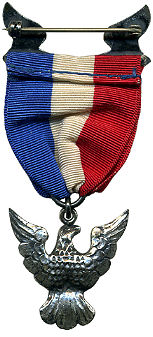
Type 1B: 1925-1926
The Type 1B is very similar to the Type 1A except that the pendant is small. The pendant is 25 mm from the top of the head to the longest tail feather with a wingspan between 27-28 mm. It has a closed beak and distinct feathers on the back. There is a distinct notch (^) where the tail feathers meet the body on the back. The ribbon is shorter than other Robbins Type 1 medals.
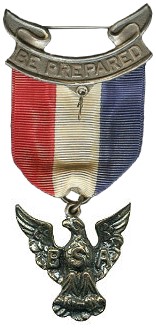
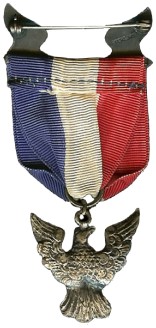
Type 1C: 1926-1930
The Type 1C is the same size as the Type 1A. The difference between the Type 1C and the Type 1A is that Type 1C has an open beak.
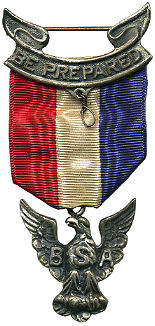
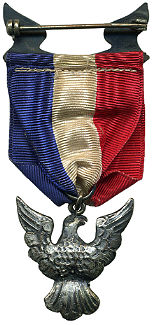
Type 1D: 1926-1930
The Type 1D has an open beak like Type 1C, but there is a straight line where the tail feathers meet the body on the back.

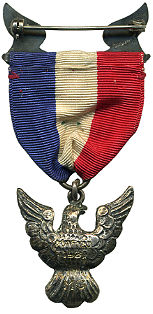
Type 2: 1930-1933
These Robbins Eagle Scout medals are among the nicest made. The engraving is extremely well done.
Back
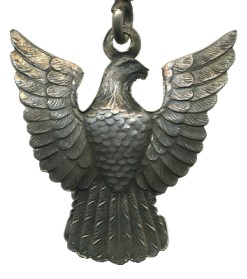
Finely Engraved: Type 2A
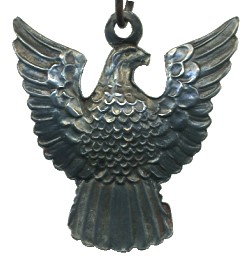
Type 2B
Type 2A: 1930
The Type 2A is very finely engraved on both the obverse and reverse making it the most attractive of all the Eagle Scout medals. The Type 2A was only made for a short time in late 1930 after which the fine details on the reverse were eliminated.


Type 2B: 1931-1933
The Type 2B, although beautiful, does not have a very finely engraved reverse but does have the same finely engraved front as the Type 2A. The reverse of this pendant is the same as the Robbins Type 3.


Type 3: 1933-1954
In 1933, the National Office decided to remove the "BSA" from the Eagle Scout medal. No variations occurred during this period in the medal.
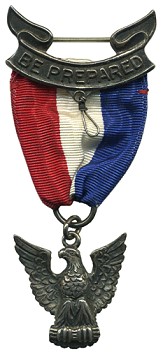
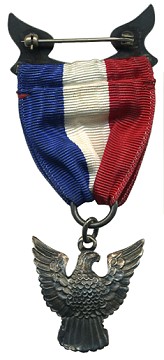
Type 4: 1955-1969
In 1954, the National Office decided to change the back to a flat back so that the pendant could be engraved. This medal was first distributed in 1955 and no variations occurred during the period of distribution.


Type 5: 1969-1978
In 1969, "BSA" returned to the breast of the Eagle, as did a fully feathered back.
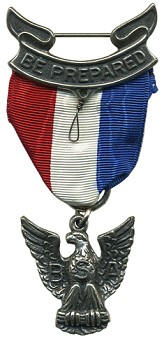
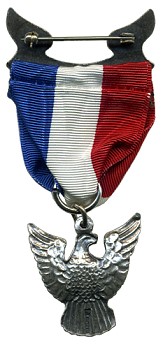
Stange: 1968-1999, 2007-Present
In 1968, the National Office asked the Stange Company to begin making Eagle Scout medals.
Type 1: 1968-1970
The difference between the Robbins Type 5 and the Stange Type 1 is in the design of the scroll. The bend in the Robbins scroll takes more of an "S" shape while the bend in Stange scroll takes more of a "V" shape.
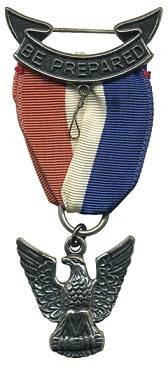
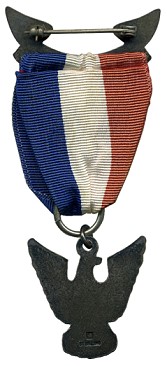
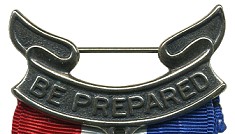
Scroll on Robbins Medal

Scroll on Stange Medal
Type 2: 1970-1974
With the change made by Robbins in 1969 to add "BSA" and a fully feathered back, the Strange Company follow suit and changed their medal in 1970. This pendant was the first die cast pendant and extra detail was added. A result of the casting was that the tail was ground down to rid it of extra silver. Thus there are different lengths of the tail feathers. The scroll remained the distinctive "V" scroll.
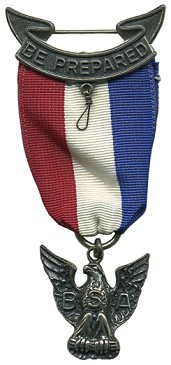

Type 3: 1974-1978
In 1974, a major change was made to the pendant. It was the same design of the newly created NESA logo. The scroll remained the distinctive "V" scroll.

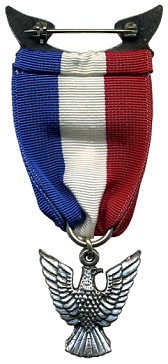
Type 4: 1978-1980
After Robbins discontinued making Eagle Scout medals in 1978, the Stange Company change their medal to the last design used by Robbins. This has created confusion between the two types.
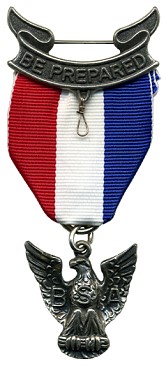
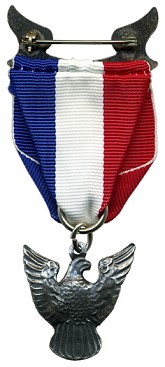
Tell the difference between Robbins Type 5 and Stange Type 4, use the ribbon and the hallmarks:
- Ribbon: The Stange ribbon shows white stitched edging (see above), which never appeared on a Robbins ribbon.
- Pendant: The Robbins pendant includes the word "STERLING" on the tail feather. The Stange pendant includes the word "STER" on the tail feathers.
- Back of the Scroll: The Robbins pendant includes a larch lower case 'r', and to the right is the word "STERLING". The Stange pendant includes a stylized 'S' and blow it is the word "STER" or "STERLING".
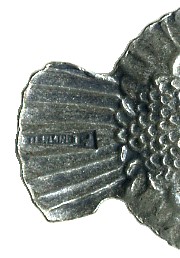
Robbins: STERLING
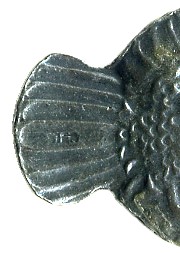
Stange: STER
Type 5: 1980-1993
Late in 1979, the price of silver rose dramatically compelling the National Office to change the metal content of the Eagle Scout medal from Sterling silver to a non-precious medal. The Stange Type 5 medals were silver plated copper, oxidized to black, buffed and lacquered. Sterling silver medals were also available upon request.
The manufacturer's hallmark, a stylized 'S', is on the tail feathers on the reverse side of all pendants. It is usually also on the back of the scroll. All the pendant backs of this type have full feathers.
Type 5A: 1980-1983
Earlier medals of the type were black because they were not buffed and lacquered. These have a shorter ribbon. The later ones of this same type were buffered and lacquered and had a longer ribbon. The back of the pendant had a flat look. All ribbons had the white edging.
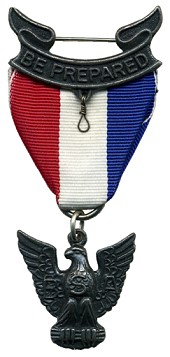

Type 5B: 1983-1986
Only the back of the pendant was changed. The wings were contoured, giving them more dimension and depth. All ribbons had the white edging.
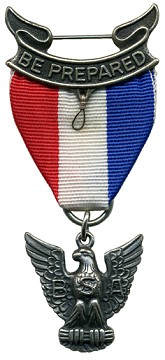

Type 5C: 1986-1989
The 'S' in "BSA" has a flattened appearance which also makes it look larger. The reverse of the pendant was changed back to the type used for the Type 5A. Some ribbons do not have the white edging.
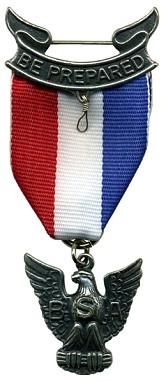
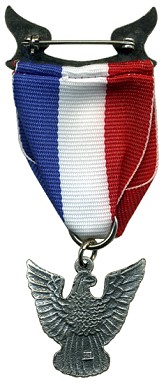
Type 5D: 1990-1993
A new die was made for this pendant. The wings were bent forward to give more dimension and depth to the pendant. The "BSA" on the breast is normal. Most ribbons do not have the white edging.
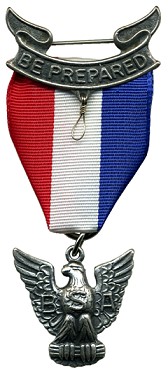

Type 5E: 1993
This type only comes in Sterling silver. The scroll is the design used in Type 6B (pin replaced with two poles for clutch holders) and the pendant is the Sterling silver pendant used in Type 5D. This combination was obviously used in order to use up stock of the older type of silver pendants. (no picture shown)
Type 6: 1993-1999
In 1993, the pendant was changed to pewter. To accommodate the softer metal, the pendant was increased in size to a height of 30 mm (head to tail) and a width 32 mm.
Type 6A: 1993
The scroll was the same that was used for Stange Type 5. This scroll was obviously used in order to use up stock before the change to Type 6B. There are no Sterling silver medals of this type.
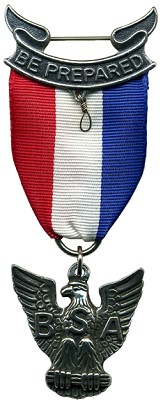

Type 6B: 1993-1999
The scroll was changed from having a pin, hinge and spin lock to one having two poles for clutch holders.
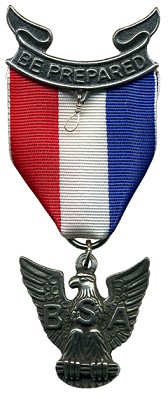

Type 7: 2007-Present
In 2007, the Stange Company was reinstated as the manufacturer of the Eagle medal. The medal is made in both sterling and non-sterling. The striking difference of the new medal is that the letters BSA are in an arc. It is also interesting to note that there are no Stange hallmarks as were on Stange Types 5 and 6.


The sterling medal has the number .925 (92.5% silver) on the tail feathers on the reverse of the pendent. The non-sterling pendent only displays the feathers.
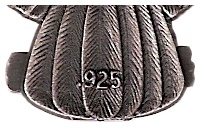
Custom Fine Jewelry: 1999-2007
In 1999, the contract for the Eagle Scout award medal was given to the Custom Fine Jewelry Company (CFJ). So at the beginning of 1999, both Stange and CFJ medals were available.
Type 1: 1999
The Stange Type 6 and the CFJ Type 1 are very similar in design. The easiest way to tell the difference is that the back of the pendant has an "S" for the Stange medals and a "CFJ" for the CFJ medals. There are Sterling silver medals of this type but they are rare. There is no mark on the pendant but the scroll has a very small "925" stamped just above the knot.

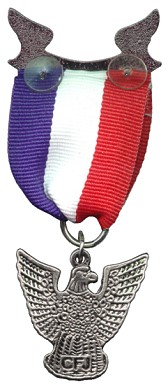
Type 2: 1999-2001
In the middle of 1999, CFJ redesigned the pendant. The new pendant had a sharp and clean look as you can see. The Sterling medals have a "925" just above the hallmark.

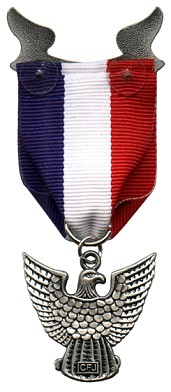
Type 3: 2001-2007
The only change between the CFJ Type 2 and CFJ Type 3 is the hanging knot. The Type 3 no longer uses a wire knot; it is a molded knot.
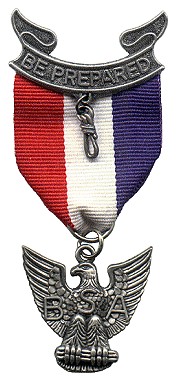
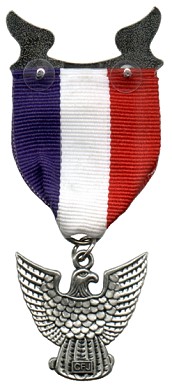
Credits:
- Terry Grove. A Comprehensive Guide to the Eagle Scout Award, Twentieth Century Edition, Reliance Media, Inc. 2008.
- Eagle Scout medals scanned from Sam Fairchild's and Terry Gove's collections.